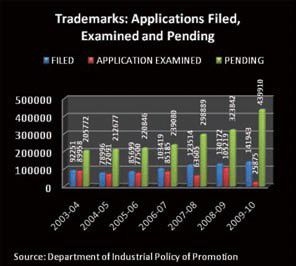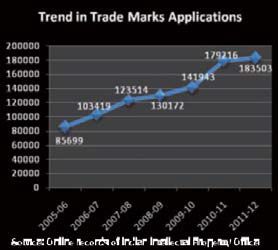- within Strategy, Real Estate and Construction and Privacy topic(s)
When Chaitanya Prasad was named Controller General of Patents, Designs and Trademarks, he was not only replacing the visionary Controller General PH Kurian; he was also joining an office which is under a myriad of backlogs and pending matters along with operational and organizational issues to deal with. Reportedly, there were some 439,910 pending trademark applications in the year 2009-2010. Prasad has promised to reorganize the Indian Intellectual Property Office with the aim to clear its huge backlogs and upgrade its technology. Prasad has been holding meetings with stakeholders to discuss the issues and demands of the industry. As many as 13 office orders were issued by the CGPDTM regarding reorganization of the functioning of the Trade Marks Registry with directions for constitution and reconstitution of several departments/sections and defining their functions and responsibilities. This article explores some of the major reforms that would be brought out by such notifications.
The Examination/Publication and Registration Section (EPR)
Applications are to be examined through the Trade Marks Automation System. Each examiner is to examine at least 50 applications per day. Examination reports proposing to accept or to advertise the application before acceptance and 20% of examination reports containing objections to acceptance of the application shall be randomly sent to Supervisory Examiners (SE) for their approval. It is interesting to note that neither the Examiner nor SE would know which reports are being sent to the SE. Five percent of the cases approved by the SE shall be sent to the officer in charge of the Examination Section for review and comments, along with a daily report, would be sent to the Controller General. The officials at the Pending Application Record Management (PARM) sections are directed to take up at least 75 cases per day wherein replies to the examination report have been received by the Registry. The Backlog PARM section has also been constituted to deal with old cases which have not been processed or updated in TMAS.

Pre-Registration Amendment Section
The notification specifically prohibits the amendments seeking substantial alteration in the trademark application. It therefore seeks to curtail the practice of making changes in the statements as to the use of the mark after the issuance of examination report. The broader ramification of this notice is yet to be seen.
The Hearing Officer at the Show Cause Hearing Section shall be allotted 300 cases on the basis of seniority of applications with directions to dispose of at least 200 cases per month. The Record, Inspection and Legal Certificate Section entrusted with the responsibility of serializing of records and files along with digitization of old records. The Amendment and Renewal Section is directed to electronically generate O-3 notices in cases where renewal is due to expire. From now on only authorized agents shall be able to file the renewal, and a request for substituting an address for service along with power of attorney shall be required to be filed if the renewal request is not filed by them. It is yet to be seen if similar change shall be made with respect to patent renewals as well.
The Controller General has also taken care of innumerable pending request for recordal of assignment, transmission or registered user agreement and has directed the hearing officer to dispose of at least 200 requests in a month. The Controller has further directed the officials at Assignment and Registered User Section to liquidate the backlog by September 30, 2012.

The functions and responsibility of the Trade Marks Registry have been reorganized, keeping in view important issues which need to be addressed on a priority basis including digitization, the updating of records of registered trademarks and the liquidation of the backlog in examination and post examination disposal. With the specific targets set for each section and formulations of various policies, an inclusive approach has been adopted by the Controller General to make the Registry more responsive to the needs of right holders. Known among his peers as tech-savvy, Prasad intends to encourage agents and applicants to opt for online filing so that manual errors may be obviated. With an ever-increasing number of trademark applications filed at the Registry, impending proposed accession to the Madrid Protocol and the demand to adopt globally-accepted IP policies, the restructuring of the Registry is more than called-for to increase the pace of examination and enhance its efficiency and transparency.
Previously published in IP Analysts June/July 2012
The content of this article is intended to provide a general guide to the subject matter. Specialist advice should be sought about your specific circumstances.

